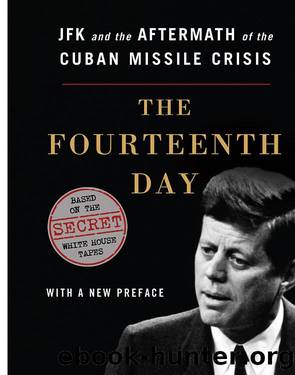The Fourteenth Day by David Coleman

Author:David Coleman
Language: eng
Format: epub
Publisher: W. W. Norton & Company
10
MISSILES OF NOVEMBER
THE PROBLEM WITH the Soviet combat troops was not just that there were more of them than U.S. officials had realized but that they were so well armed. As far as U.S. intelligence could tell, each group consisted of about 1,250 men, with its own support structure. They could operate independently, making them highly mobile. That meant they could be an effective force against an amphibious invasion. The regiments had the kind of sophisticated, battlefield military hardware one would expect: armored personnel carriers, self-propelled artillery, tanks, antitank wire-guided missiles, heavy engineering machinery, and at least three types of short-range missiles. They could put up real resistance to any ground invasion.1 âThis is first-line stuff,â Wheeler told Kennedy. Taylor agreed: it was equipment âweâve never seen in the hands of satellites.â2
They had counted up to 150 cruise missiles in Cuba, although they never fully appreciated that that total included two distinct varieties, one of which was nuclear capable.3 The first were Sopka cruise missiles designed for protecting coastlines from amphibious attack. They resembled small jet airplanes, had a range of between 40 and 110 miles, and were armed with 2,000-pound conventional warheads.4 The second kind of cruise missiles were the FKRs. They had a range of between 90 and 110 miles and were armed with nuclear warheads of between five and twelve kilotons. Their combat role in Cuba was primarily to protect beachheads and target the U.S. naval base at Guantánamo Bay from the hills around the base. U.S. intelligence never identified the FKRs, apparently counting them as Sopka rockets.5 The Soviets sent to Cuba eighty nuclear warheads for the FKRs.6
By far the most numerous of the short-range missiles were part of the sophisticated surface-to-air missile system known in the West as the SA-2. By the middle of October, there were approximately five hundred SA-2 missiles distributed over a sophisticated air defense network of twenty-four SAM sites across the island. With their state-of-the-art radar network, a lateral (or âslantâ) range of 25 to 30 nautical miles, an effective vertical range up to about eighty-thousand feet, and a 500-pound high-explosive warhead, these missiles posed a serious threat to aircraft but little threat to anything on the ground or at sea.7 The technology behind the SA-2 systems was state-of-the-art, in some respects more advanced than the Hawk missiles that the United States had just recently begun supplying to Israel.8 U.S. intelligence analysts concluded that although it was technically conceivable that the SA-2s could be armed with a nuclear warhead to turn them into a potent surface-to-surface missile with about a 100- to 150-mile range (that could be done with the American Nike Hercules missileââOur Nike Hercules is quite a good surface-to-surface missile,â Taylor said), it was also âhighly improbable.â9
There were other types of missiles, including air-to-air missiles and antiship missiles. The Soviets sent to Cuba between twelve and sixteen Komar-class guided-missile patrol boats. The Komars were similar to motor torpedo boats, but instead of torpedoes, each carried two short-range cruise missiles with a range of 10 to 15 nautical miles.
Download
This site does not store any files on its server. We only index and link to content provided by other sites. Please contact the content providers to delete copyright contents if any and email us, we'll remove relevant links or contents immediately.
| Africa | Americas |
| Arctic & Antarctica | Asia |
| Australia & Oceania | Europe |
| Middle East | Russia |
| United States | World |
| Ancient Civilizations | Military |
| Historical Study & Educational Resources |
Never by Ken Follett(2884)
The Man Who Died Twice by Richard Osman(2300)
Machine Learning at Scale with H2O by Gregory Keys | David Whiting(2293)
Fairy Tale by Stephen King(2072)
Will by Will Smith(2043)
Rationality by Steven Pinker(1765)
The Dawn of Everything: A New History of Humanity by David Graeber & David Wengrow(1571)
The Dark Hours by Michael Connelly(1571)
Principles for Dealing With the Changing World Order: Why Nations Succeed and Fail by Ray Dalio(1378)
Friends, Lovers, and the Big Terrible Thing by Matthew Perry(1330)
A Short History of War by Jeremy Black(1300)
HBR's 10 Must Reads 2022 by Harvard Business Review(1256)
Go Tell the Bees That I Am Gone by Diana Gabaldon(1236)
Can't Hurt Me: Master Your Mind and Defy the Odds - Clean Edition by David Goggins(1228)
515945210 by Unknown(1209)
Fear No Evil by James Patterson(1110)
443319537 by Unknown(1074)
Works by Richard Wright(1020)
Going There by Katie Couric(993)
